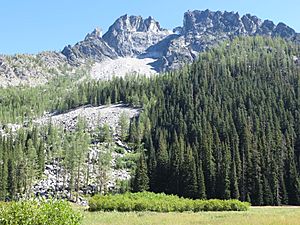Bearcat Ridge facts for kids
Quick facts for kids Bearcat Ridge |
|
|---|---|

Bearcat Ridge high point, west aspect
|
|
| Highest point | |
| Elevation | 7,960 ft (2,430 m) |
| Prominence | 644 ft (196 m) |
| Isolation | 1.08 mi (1.74 km) |
| Parent peak | Emerald Peak 8,422 ft |
| Geography | |
| Location | Chelan County Washington, U.S. |
| Parent range | Chelan Mountains North Cascades Cascade Range |
| Topo map | USGS Lucerne |
| Type of rock | hornblende quartz diorite, granodiorite |
| Climbing | |
| First ascent | |
Bearcat Ridge is a mountain ridge in Washington state. It stands about 7,960 feet (2,426 meters) tall. You can find it in Chelan County, within the Chelan Mountains.
This ridge is right on the edge of the Glacier Peak Wilderness. It is also part of the Wenatchee National Forest. The closest taller mountain is Emerald Peak, which is about 1.1 miles (1.8 km) away. Another nearby peak is Cardinal Peak, located about 1.76 miles (2.8 km) to the south. Water from Bearcat Ridge flows into Lake Chelan. This happens through two creeks called Emerald Creek and Bearcat Creek. The ridge acts like a natural wall, separating these two creek valleys.
Weather on Bearcat Ridge
Most of the weather in this area comes from the Pacific Ocean. It usually moves northeast towards the Cascade Mountains. When these weather systems hit the tall peaks of the North Cascades, they are forced to rise. This causes them to drop their moisture as rain or snow. This process is called Orographic lift.
Because of this, the North Cascades get a lot of rain and snow. This is especially true during the winter months. Winters are often cloudy here. But in the summer, high-pressure systems over the Pacific Ocean bring clear skies. This means there is often little or no cloud cover during the warmer months.
How Bearcat Ridge Formed
Bearcat Ridge is mostly made of rocks called granodiorite and hornblende quartz diorite. These rocks are part of a larger rock body known as the Cardinal Peak pluton. The North Cascades are known for their very rugged landscape. They have sharp peaks, tall spires, long ridges, and deep valleys carved by glaciers.
The amazing shapes of the Cascade Mountains were created over millions of years. This happened because of big geological events. The history of these mountains goes back to the late Eocene Epoch. At that time, the North American Plate was slowly moving over the Pacific Plate. This caused many volcanic eruptions. For example, Glacier Peak, a large stratovolcano, started forming about 23 miles (37 km) west of Bearcat Ridge.
Also, small pieces of the Earth's crust, called terranes, came together to form the North Cascades about 50 million years ago. Later, during the Pleistocene period, which was over two million years ago, glaciers moved across the land many times. As they moved, they scraped away rock and left behind debris. The "U"-shaped valleys you see today were carved by these ancient glaciers. The combination of land being pushed up (called uplift) and cracks in the Earth's crust (called faulting), along with the glaciers, created the tall peaks and deep valleys of the North Cascades.




